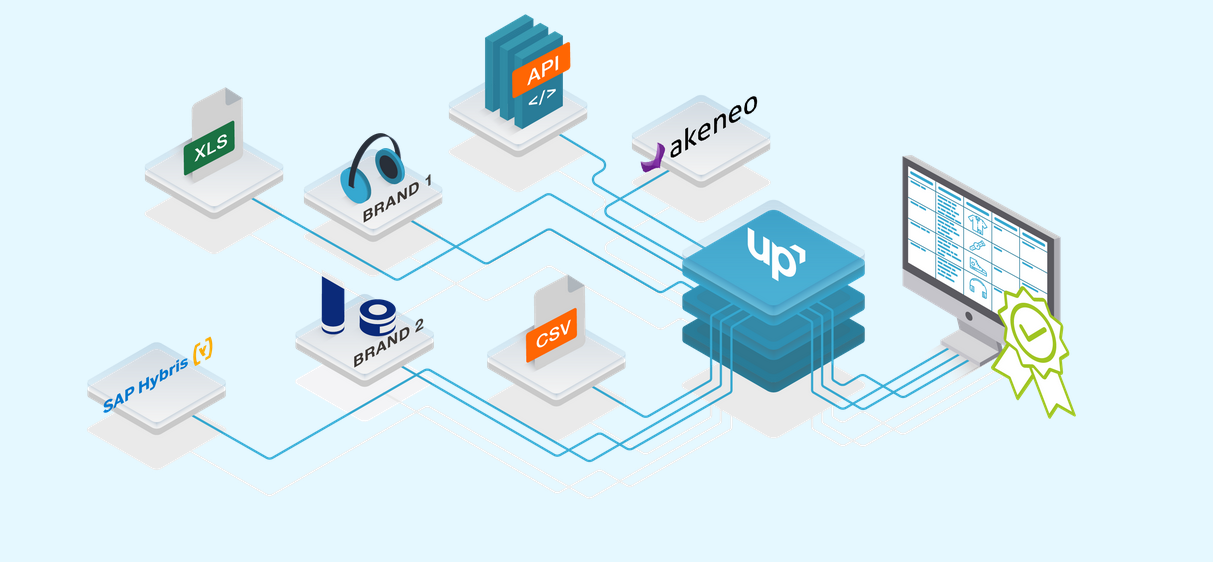Are you a retailer, affiliate, wholesaler, or distributor who aggregates product data from external partners and businesses or from multiple places within your own enterprise? If so, this article on data aggregation is for you.
Depending on the structure and objectives of your company, data aggregation can be the act of:
- combining product data from multiple sources to create a single, manageable format.
- collecting missing or value-adding product information to boost feed quality.
In both cases, product information is pulled directly from a variety of different sources (i.e. a retailer’s PIM system, your company’s DAM system, etc.) However, the way data is presented in retailer A’s PIM system will simply not match that in retailer B’s - and most importantly- it won’t match the data structure defined by your company. As a result, with each new source, your team must deal with a new format. This includes, but is not limited to:
- reviewing & standardizing individual attributes, as they may be named differently between sources
- mapping, merging or splitting data according to your own company’s formatting preferences
- identifying and filling in missing fields and/or images
- implementing additional attributes
- monitoring and adjusting text length
- changing file type
All of the above is done in an effort to create a single, unified master data set. But how?
All too often, enterprise businesses attempt to carry out data aggregation manually. This approach requires a heavy reliance on human resources which can include the IT department, freelancers, and interns. Executing the task manually means structuring hundreds or thousands of unique data sets from equally as many sources. This is highly complex and time-intensive and can lead to a number of very negative consequences that could limit companies’ overall revenue potential.
This article will take a look at the costly repercussions that can accompany manual data aggregation. Then, we’ll explain what you’ll need in order to implement a more efficient approach.

The costly consequences of manual data aggregation
Aside from simply being an outdated approach, manual data aggregation in enterprise-level companies can cause some serious, revenue-damaging consequences. If your company is still using the legacy approach, you’re likely to experience the following:
Slow time-to-market
Each client or retailer will submit their own feed via different sources and in a different format. With so many variations, it’s simply not easy, nor efficient, to manually standardize each feed to suit the structure defined by your company.
Not only will you need to map each individual feed according to your company’s layout, but you’ll also need to check the contents within each feed. This process can take months and cause serious roadblocks when it comes to getting your products to market quickly, ultimately restricting your company’s agility and blocking you from new channels and revenue-driving opportunities.
Excess spend on internal resources
With any manual task comes the need for an employee to see it through. Manual data aggregation is a constant, ongoing task that would need to be added to the daily work of several employees. Essentially, you end up paying full salaries for unnecessary tasks, ultimately wasting money and may even be putting highly skilled workers on tasks far below their level.
Inability to scale
Manual data aggregation often required heavy support from a company’s IT department. Every time a new feed needs to be imported, valuable employees will need to devote hours or weeks of their time to structure the data according to company standards. This leaves key individuals tied up performing manual maintenances instead of innovating and coming up with new opportunities to expand your business.
Moreover, manual data aggregation is simply not sustainable for companies looking to continuously grow and add new vendors. All too often, enterprise businesses are barely able to keep up with their current feeds. As a result, they are unable to even consider scaling or implementing new endeavors.
Loss of revenue
What’s more is the financial burden that stems from human error during manual data aggregation. One of theleading causes of chargebacks is incorrect or poorly structured product data feeds according to the export channels requirements. This issue often occurs as a result of human error and the manual handling of product content.
Moreover, if your product content does go live, but has not been optimized due to lack of time and resources, you’re likely to miss out on a lot of sales. Both your channels and end customers want clean, complete, and correct product content. Anything less is simply not likely to convert.
If any of these problems seem familiar, the chances are, you’re managing your product data manually. However, there’s no need to fear. Modern enterprises can tackle these issues head-on by leveraging end-to-end product data aggregation and syndication software like Productsup.
Optimize your company's approach to data aggregation with automation
The most efficient and proven approach to data aggregation includes automation. By eliminating manual tasks, you instantly remove the risk for human error, while simultaneously freeing up your company’s most valuable assets (i.e. your IT department).
Moreover, automated data aggregation can help your business get to market in a fraction of the time. Instead of spending weeks to months onboarding a new vendor feed, the entire process can be completed in just minutes. As a result, you gain the agility necessary to capture new revenue-driving opportunities as they come.
With Productsup, for example, you’re able to pull data from almost anywhere and aggregate it in one format with next to no manual work required. Just set up the processes once and let them run. No matter the size, complexity, or quantity of feeds, data aggregation with Productsup is quick, easy, and scalable.

Productsup lets you:
- Keep data up-to-date with minimal work
- Keep data clean by removing manual work and the possibility for human error
- Reduce resource and time usage, particularly in terms of IT
- Import from any PIM, MDM, PCM, ERP or legacy back-end system
- Leverage your PIM to create both a Golden Record and easily modified agile record
Thanks to our one-of-a-kind Dataflow, you have a visual overview of the data mapping process, which is both automated and customizable.
The platform has integrations to a large variety of data sources – from the most popular shop systems to PIM software and third-party data suppliers.
Find out how one client increased monthly merchant integrations from 5 to 100+ with Productsup! Read full case!
Seamless end-to-end product data aggregation, optimization, and syndication
Optimizing your approach to enterprise-level data aggregation calls for much more than a basic tool. With Productsup, it’s never been easier to merge, cleanse, structure, and standardize massive data sets. No feed is too large, no number of sources is too many.
Productsup allows you to stay agile and at the forefront of digital transformation by automating integration, aggregation, optimization, and syndication. The software has everything you need to future-proof your business.
To learn more about the future of your product data management, book a free demo. Let us show you how easily you can turn a time-consuming, resource-devouring task into set-it-and-forget-it.

![[WP Import] Data aggregation for enterprise made simple with automation](http://images.ctfassets.net/q17uls4wkkdz/1AGVgYZ2h6YEU5yvbxfkgw/11f145544b16999588e08eb7a7a276f8/enterprise_data_aggregation_ft_image.jpg?w=1200&h=675&fit=FILL)